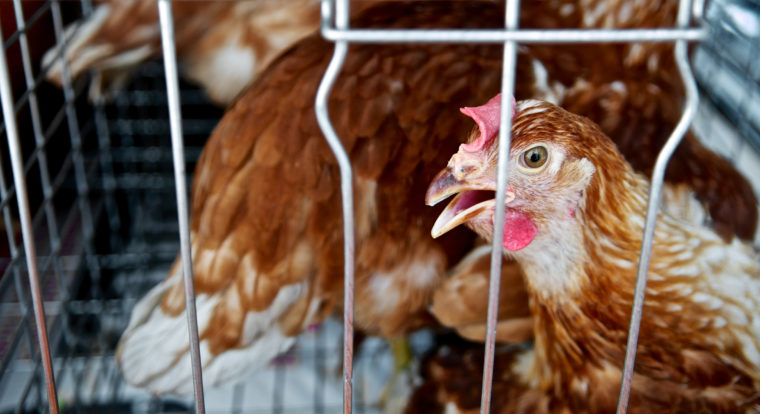

In the United States, animal protection laws can be enacted and enforced at every level of government.
Most animal protection legislation happens at the state level. There are also a handful of federal animal protection laws. Additionally, some cities and counties pass ordinances to protect animals.
This is why it’s critically important to advocate for better animal protection laws with lawmakers in all government bodies. Each has the power to help.
There are only a handful of federal animal protection laws:
The Animal Welfare Act : Signed into law in 1966, the Animal Welfare Act (AWA) is the primary federal animal protection law. The AWA mainly involves animals kept at zoos and used in laboratories, as well as animals who are commercially bred and sold like those in puppy mills.

The AWA directs the Secretary of the United States Department of Agriculture to set minimum standards regarding these animals’ “handling, care, treatment, and transportation.” Dog fighting and cockfighting are also prohibited under the Animal Welfare Act, so long as the activity in some way crosses state lines.
The AWA itself, as well as its enforcement by the Department of Agriculture, are frequently criticized for allowing inhumane practices to go unchecked.
The “28 Hour Law“: This law, enacted in 1873, requires vehicles transporting certain animals for slaughter to stop every 28 hours to allow the animals exercise, food and water. The law does not apply if the vehicle in which animals are being transported contains access to food or water, and there are many other exceptions as well. Birds like chickens and turkeys, which are the most-farmed animals in the United States, are considered exempt by the federal government.
The Humane Slaughter Act, or the Humane Methods of Livestock Slaughter Act : This law was first passed in 1958, then amended in 1978. The Humane Methods of Slaughter Act requires that animals be stunned into unconsciousness before slaughter, to minimize pain.
Though chickens, turkeys and other birds feel pain just like other animals, they are not protected by this law. Enforcement of this law has been found by government inspectors to be “inconsistent.”

The Endangered Species Act : Enacted in 1973, the Endangered Species Act protects fish, mammals and birds – as well as plants – listed as threatened or endangered in the United States and beyond. The ESA outlines procedures for federal agencies to follow regarding listed species, as well as criminal and civil penalties for violations. This law is chiefly administered by the U.S. Fish and Wildlife Service and the U.S. National Oceanic and Atmospheric Administration Fisheries Service.
Since 1979, the Animal Legal Defense Fund has been the leader in the fight to win animals the legal protection they so desperately need—and deserve. Your generous support is vital to our continued success.
The PACT (Preventing Animal Cruelty and Torture) Act: Signed into law in 2019, the PACT Act makes some of the most egregious forms of animal cruelty — specifically crushing, burning, drowning, suffocating, impaling or sexual exploitation — in or affecting interstate commerce or within the territorial jurisdiction of the United States a federal crime.
The Animal Crush Video Prohibition Act banned the creation and distribution of so-called “crush videos” — where people torture, crush, and kill small animals, such as puppies and hamsters, for the titillation of viewers — in 2010. The PACT Act goes a step further and bans the underlying animal cruelty contained in them.
The vast majority of animal cruelty laws are at the state level. The PACT Act creates a corresponding federal animal cruelty statute . While the PACT Act is a significant step forward for animals, it’s important to note its limitations. Among its numerous exemptions are “customary and normal” agricultural and veterinary practices as well as slaughtering animals for food.
The Lacey Act: Enacted in 1900, the Lacey Act bans illegal wildlife trafficking. It was the first federal law protecting wild animals. Specifically, it prohibits trade in wildlife and plants that have been illegally taken, possessed, transported, or sold. It also prohibits the falsification of documents regarding the sale and shipment of wildlife. For example, the Lacey Act can be used to prosecute a dealer who sells endangered turtles smuggled from Costa Rica or a roadside zoo who falsifies documents to sell a tiger cub across state lines.
The Swine Health Protection Act: Passed in 1980, and enforced by the U.S. Department of Agriculture’s (USDA) Animals and Plant Health Inspection Service (APHIS), the Swine Health Protection Act (SHPA) is an anti-garbage feeding law and designed to minimize threats to public health, including the heightened risk from zoonotic diseases. “Garbage” is defined as “all waste material derived in whole or in part from the meat of any animal” and any refuse that has come in contact with it.
Garbage feeding is illegal under the SHPA, but the law does allow states to create regulated permitted programs if they choose to. If a state chooses to institute a program, the SHPA has requirements that must be met. Read more about the federal law.
Most animal protection laws are enacted and enforced at the state level.
Because there are so many state laws involving animal protection, this won’t be a detailed guide, but an overview of the types of laws you’ll generally find at the state level. We recommend you check out the Animal Legal Defense Fund’s annual Rankings Report on the best and worst states for animal protection laws for more in-depth information.
State animal protection laws are primarily concerned with companion animals, though there are also some state wildlife protection laws. Farmed animals and animals used in laboratories are often excluded from state animal protection laws, as are wildlife in some contexts.
Each of the 50 states now has a felony animal cruelty law on the books. Each state determines what constitutes cruelty, and the penalties for committing cruelty.